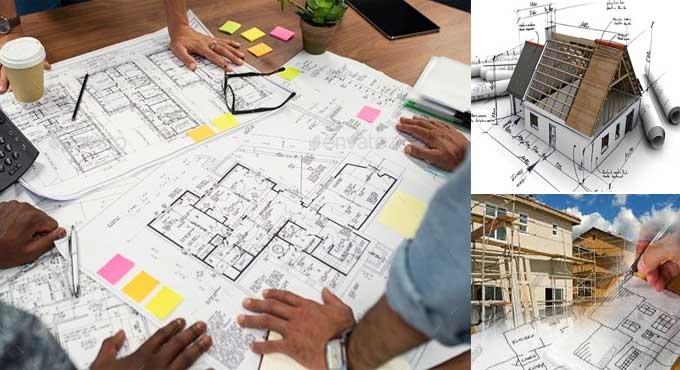
10 Major Types of Construction Drawings used in Building Construction
Construction drawing is one type of visualization of user want to build layout, the components, framework, dimensions, and much more. Users can describe every detail and aspect of construction to the world using construction drawing.
The architect has to think about how to use the workforce efficiently and reduce time by drawing something out of the box.
Types of Software uses in Construction Drawing
Nowadays, the plan of Construction is not handwritten anymore. There are various software like CAD (Computer-aided design) is used for sketching and rendering. BIM and VCM are game-changing the concept of construction drawings, those software are user-friendly and easy to rendering and visualizing in detail.
Following are 10 Types of Construction Drawings:
1. Block Plan
Block Plan can map out in a layout site or the surrounding buildings of the whole area.
- These types of drawing help you understand the basic things of construction like roads, boundaries of your site.
- Architects can help other workers and engineers with their construction plan.
- Architects make Ordnance Survey Maps with the recommended scales like 1:2500, 1:1250, or 1:500 using Block Plan.
2. Architectural Drawings
Architectural Drawing is one kind of drawing work uses in building drawings. The dimensions, depth, the actual building layout, can be portrayed at the beginning of the construction. Engineers envisioned their project as a blueprint construction through Architectural Drawing.
Different types of Architectural Drawing generally used are:
- Foundation plan: Normal people might think it is used for the foundation of construction. But it?s not like that. A foundation plan is one kind of drawing where the Architect can visualize the dimensions and size of rooms along with their windows and doors.
- Floor plans: It is used in the rendering of each room on every floor. Floor plans may be 2D or 3D as per the use of architects both domestic as well as commercial buildings.
- Sectional Drawings: This type of drawing is used in a part or section of construction. It is used in huge projects where you need to work on certain parts. Depth, Height, and Hollowness can measure in various buildings of a particular construction.
- Elevation Drawings: The Architect implements the general idea of relative surface, internal markings, and relative height of different components like columns, doorframes, and window frames.
3. Production Drawings
Production Drawing is the most important thing for an architect. Engineers and workers can do their work with these Construction Drawings. The materials, various parts assembling, the tools required, the dimensions, and other vital information while constructing the buildings by the workers. The Architect has to be pitch-perfect with their drawings otherwise it will jeopardize the whole project.
4. Structural Drawings
Structural Drawings helps workers and on-site engineer to understand the physical aspect of a building framework.
These drawings have four types:
- Excavation Drawing: These types of drawing are used in particular positions and dimensions in smaller works like tunneling, soil removal, and grid plan.
- Column Layouts: Just like the name, Architect uses it to describe contractors the foundation of the column layout, and position of each column, and the distance between it.
- Beam Layouts: Beam supports the roof and windows and it boosts the structure. The layout of the structure is crucial for covering the length and height of a particular point of it.
- Roof slab layouts: The Architect uses AutoCAD for getting a precise layout of the roof where each slab requires for roof with exact dimensions.
5. Electrical drawings
Electrical drawings use to layout the electric line of the particular building of both residential and commercial.
Details included in Electrical Drawings are:
- Earthing layout
- Light fixture layout
- Generator and other equipment
- Cable tray layout
- Hazardous area classifications
- Lighting protection system
6. Plumbing Drawings
Plumbing is another part of any residential or commercial construction drawing that marks the points to set up plumbing components. Architects left enough space for pipe and sanitary ware to add once the structural component ends.
Plumbing drawings generally consist of:
- Pipes like water pipes, drainage pipes, internal pipes
- Pipes material
- Outlet points like taps, sinks, tanks, etc
- Position and location of pipes and outlets
7. HVAC Drawings
HVAC Drawing is also known as mechanical construction drawing provides details and design framework for heating and ventilation systems in a building. Central heater or Central A.C, air conditioning vents, ventilators, and others will be added to the requirement of the building design.
8. Firefighting Drawings
The Architect has to think about safety before layout a design of the structure in today?s construction systems. Firefight Drawing is one kind of blueprint building drawings that distribute points for fire hoses, fire escapes, water outlets, sandbags, or any other fire safety equipment requisite by the fire department.
9. Environmental Plans
Global warming is impacting our climate day by day. So architect has to follow environmental guidelines and management to their construction projects. The construction project has to be eco-friendly and does not damage any other damage to the environment.
There is some key point of check the structure eco-friendly
- Chemical disposal mechanisms
- Management of erosion and sedimentation
- Outlining environmental guideline compliance measures
- Measures to handle accidents and emergencies like fire
10. Finishing Drawings
The building needs aesthetic and functional value after building up the whole structure to showcase the design layout that is created by the architect.
Details of Finishing Drawings:
- Tile patterns,
- Floor patterns
- False ceilings
- Paint colors and textures
- Plaster
- Woodwork
- Motifs and designs


